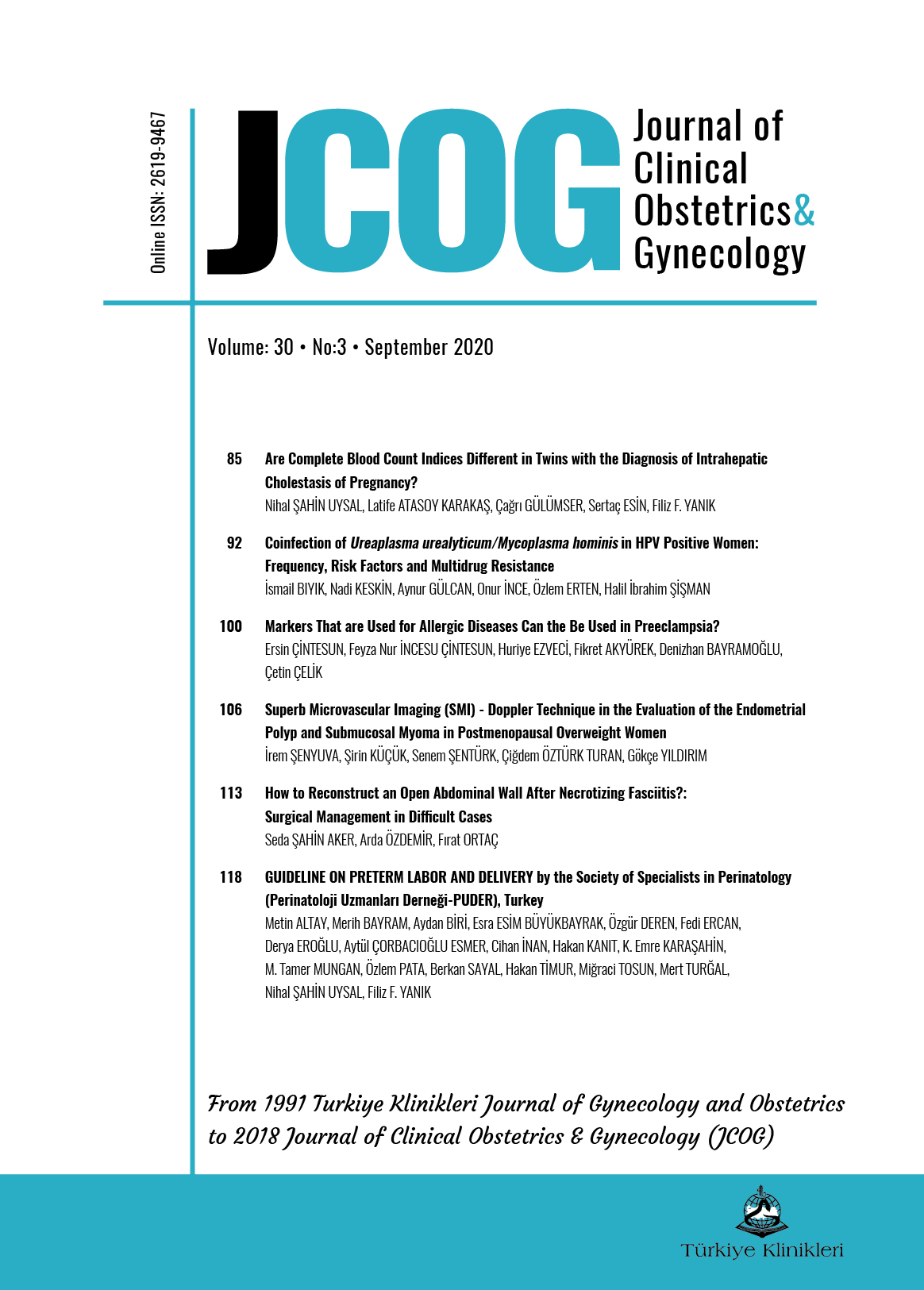Open Access
Peer Reviewed
CASE REPORTS
2217 Viewed1199 Downloaded
How to Reconstruct an Open Abdominal Wall After Necrotizing Fasciitis?: Surgical Management in Difficult Cases
Received: 18 May 2020 | Received in revised form: 30 Sep 2020
Accepted: 13 Oct 2020 | Available online: 12 Nov 2020
J Clin Obstet Gynecol. 2020;30(3):113-7
DOI: 10.5336/jcog.2020-76430
Article Language: EN
Article Language: EN
Copyright Ⓒ 2025 by Türkiye Klinikleri. This is an open access article under the CC BY-NC-ND license (http://creativecommons.org/licenses/by-nc-nd/4.0/)
ABSTRACT
Necrotizing fasciitis (NF) is a very fatal infection which is also known as flesh eating disease. Due to the rapid progression, early diagnosis, the use of broad spectrum antibiotics and aggressive surgical treatment are very essential to reduce morbidity and mortality. In some conditions, abdominal wall integrity cannot be maintained. Negative pressure wound therapy (NPWT) can be used for the management of acute and chronic wounds. Studies showed that negative pressure wound therapy combined with a split thickness skin graft (STSG) can help to heal wounds at NF. In this case, the patient suffered from type 1 NF caused by Pseudomonas aeruginosa, Klebsiella pneumoniae. We would like to demonstrate how to reconstruct an open abdominal wall after an endometrial carsinoma surgery with NPWT and STSG.
Necrotizing fasciitis (NF) is a very fatal infection which is also known as flesh eating disease. Due to the rapid progression, early diagnosis, the use of broad spectrum antibiotics and aggressive surgical treatment are very essential to reduce morbidity and mortality. In some conditions, abdominal wall integrity cannot be maintained. Negative pressure wound therapy (NPWT) can be used for the management of acute and chronic wounds. Studies showed that negative pressure wound therapy combined with a split thickness skin graft (STSG) can help to heal wounds at NF. In this case, the patient suffered from type 1 NF caused by Pseudomonas aeruginosa, Klebsiella pneumoniae. We would like to demonstrate how to reconstruct an open abdominal wall after an endometrial carsinoma surgery with NPWT and STSG.
REFERENCES:
- File Jr TM, Tan JS, DiPersio JR. Group A streptococcal necrotizing fasciitis. Diagnosing and treating the "flesh-eating bacteria syndrome". Cleve Clin J Med. 1998;65(5):241-9. [Crossref] [PubMed]
- Carter PS, Banwell PE. Necrotising fasciitis: a new management algorithm based on clinical classification. Int Wound J. 2004;1(3):189-98. [Crossref] [PubMed]
- Kihiczak GG, Schwartz RA, Kapila R. Necrotizing fasciitis: a deadly infection. J Eur Acad Dermatol Venereol. 2006;20(4):365-9. [Crossref] [PubMed]
- Gupta S. Optimal use of negative pressure wound therapy for skin grafts. Int Wound J. 2012;9 Suppl 1:40-7. [Crossref] [PubMed]
- Puvanendran R, Huey JCM, Pasupathy S. Necrotizing fasciitis. Can Fam Physician. 2009;55(10):981-7. [PubMed]
- El-Menyar A, Asim M, Mudali IN, Mekkodathil A, Latifi R, Al-Thani H, et al. The laboratory risk indicator for necrotizing fasciitis (LRINEC) scoring: the diagnostic and potential prognostic role. Scand J Trauma Resusc Emerg Med. 2017;7;25(1):28. [Crossref] [PubMed] [PMC]
- Wong CH, Khin LW, Heng KS, Tan KC, Low CO. The LRINEC (Laboratory Risk Indicator for Necrotizing Fasciitis) score: a tool for distinguishing necrotizing fasciitis from other soft tissue infections. Crit Care Med. 2004;32(7):1535-41. [Crossref] [PubMed]
- Nawijn F, Smeeing DPJ, Houwert RM, Leenen LPH, Hietbrink F. Time is of the essence when treating necrotizing soft tissue infections: a systematic review and meta-analysis. World J Emerg Surg. 2020;8;15:4. [PubMed]
- Fleischmann W, Strecker W, Bombelli M, Kinzl L. [Vacuum sealing as treatment of soft tissue damage in open fractures]. Unfallchirurg. 1993;96(9):488-92. [PubMed]
- Ye J, Xie T, Wu M, Ni P, Lu S. Negative pressure wound therapy applied before and after split-thickness skin graft helps healing of Fournier gangrene: a case report (CARE-Compliant). Medicine (Baltimore). 2015;94(5):e426. [Crossref] [PubMed] [PMC]
- Arslan E, Ozturk OG, Aksoy A, Polat G. Vacuum-assisted closure therapy leads to an increase in plasma fibronectin level. Int Wound J. 2011;8(3):224-8. [Crossref] [PubMed]
- Vuerstaek JDD, Vainas T, Wuite J, Nelemans P, Neumann MHA, Veraart JCJM, et al. State-of-the-art treatment of chronic leg ulcers: a randomized controlled trial comparing vacuum-assisted closure (V.A.C.) with modern wound dressings. J Vasc Surg. 2006;44(5):1029-37. [Crossref] [PubMed]
- Kovacević P, Velickov A, Stojiljković D, Velickov A, Ceranić Z. Reconstruction of full thickness abdominal wall defect following tumor resection: a case report. Srp Arh Celok Lek. 2014;142(5-6):347-50. [Crossref] [PubMed]
MENU
POPULAR ARTICLES
MOST DOWNLOADED ARTICLES





This journal is licensed under a Creative Commons Attribution-NonCommercial-NoDerivatives 4.0 International License.










